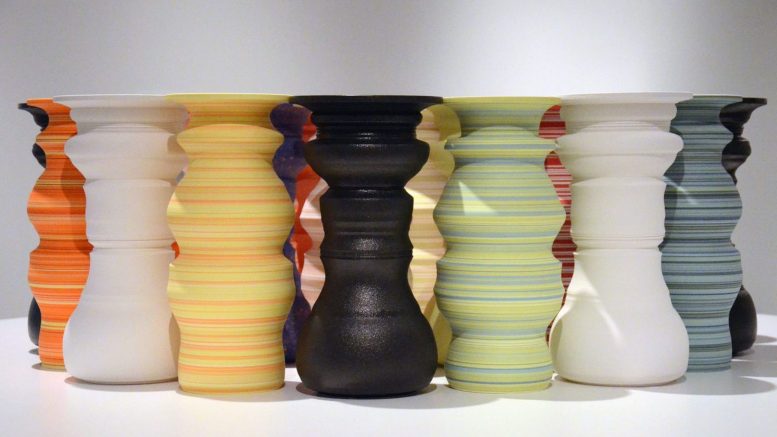The Winnipeg Art Gallery (WAG) is currently housing a small exhibition by Canadian ceramicist Greg Payce called Orrery. Featuring a single work by the same name, Orrery was curated by Riva Symko, head of collections and exhibitions at the WAG. The work is a recent acquisition into the WAG’s permanent collection and was donated to the gallery by the artist.
Orrery consists of 24 ceramic vessels which are arranged on a mechanized platform that rotates the various rows of sculptures and imitates the movement of celestial bodies. More specifically, the WAG’s website explains its title “references the popular astronomic mechanical model used to represent the positions, motions and phases of the solar system.”
The rotation of these vessels in the fashion of planetary orbits also does something unique around each vase — it animates the negative space between them, revealing the general profiles of men and women as they turn. As the WAG explains, ceramics have historically always had a close relationship with the human body both in decoration and creation of vessels, and Payce believes “vessel forms are essentially abstractions of human forms.”
This creates a more complex conceptual background for us to consider, leaving us to reflect upon the relationships between the materials in Orrery, history and our place in the universe.
The work’s overall conceptualization is incredibly fascinating — from the parallels drawn between celestial, ceramic and anthropomorphic bodies in Orrery to the ideas of harnessing the same orbits that exist in space and bringing them to our earthly realm. The installation provides a commentary on the unifying and humbling experience of humanity in consideration of our place within the vastness of the universe.
However, the execution of this enormous concept ultimately felt underwhelming upon viewing. That isn’t to discount the quality of Payce’s skill in making ceramics — a tremendous amount of skill and effort evidently went into making these vessels and aligning them perfectly in their installation, and the vessels themselves seem to be well made and nice to look at. They just didn’t deliver on the grand scale the WAG’s website made them out to be.
You need to spend a little time with Orrery to get acquainted with it. Unfortunately, it was placed in an area where many of the other shows on display at the WAG are visible — the other larger rooms are simply more enticing than the small white cube in which Orrery sits alone, which makes it more difficult to sit with the slow-moving and introspective piece.
Additionally, while the figurative elements in Orrery are clear, after reading the wall didactic and essay on the WAG’s website, it becomes obvious the piece could have more variation to it. The use of varying sizes of vessels and other shapes to create different silhouettes would have made the piece more interesting to watch for a longer duration of time. While Orrery‘s rotational element did provide some intrigue, its inner circles didn’t offer any new visual material that challenged you to really stay with the piece. The work might have been more impactful on a larger scale.
Last but not least, the WAG’s description of the human figures seen in Orrery as “erotic interpretation” does not seem fitting. Certainly, sexuality and eroticism have played historical roles in ceramics, but it’s uncertain where this eroticism is meant to come into play in Orrery. Although the figures depicted in Orrery are nude, it doesn’t imply erotic undertone, and nothing else about piece in particular implies an erotic element due to the neutral posture of each figure and bright colour palette.
If any eroticism was intended on the part of the artist, it would have been more interesting to have it at the forefront of the conversation surrounding Orrery without beating around the bush. Beyond the merging of figures between rotating rows, there is little action between any of the figures which leads me to interpret the piece as commentary on the universality of human experience and how that experience can simultaneously be physical and immaterial.
This, in my perspective, better lends itself to the discussion of broader relationships between the orrery, celestial bodies, clay and human nature.
But, as we all know, art is subjective.
You can visit Orrery at the Winnipeg Art Gallery to make your own observations and interpretations until March 27.





